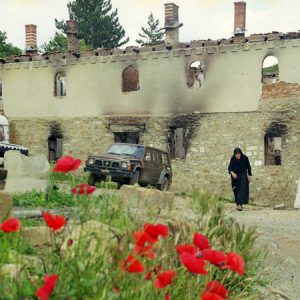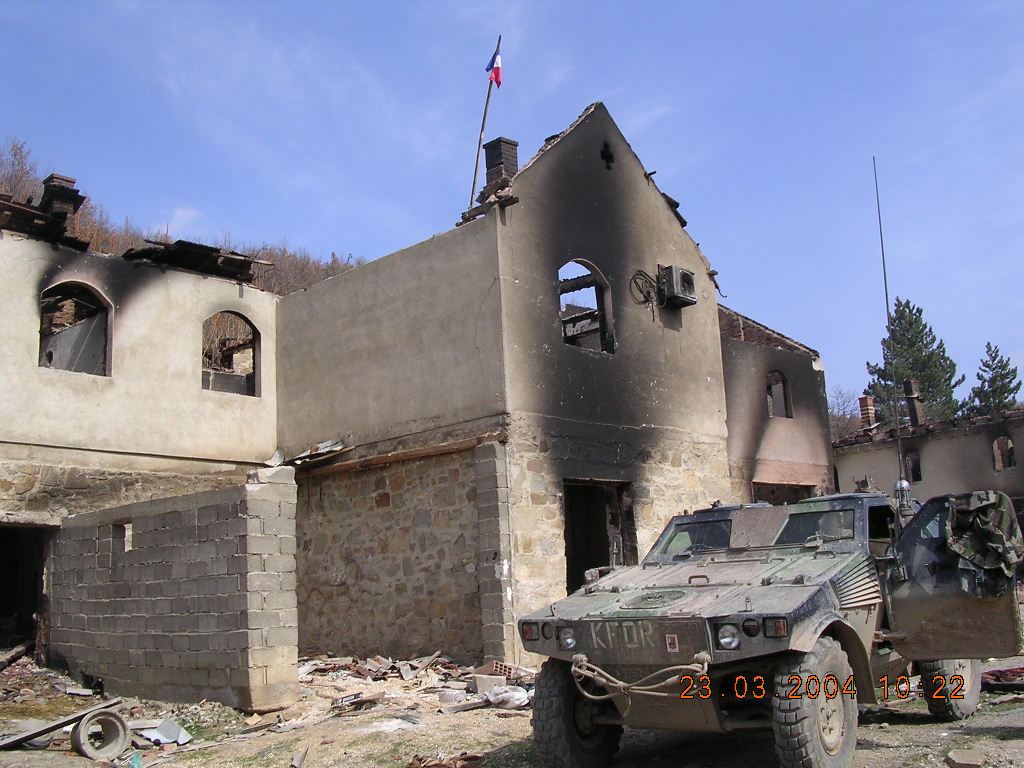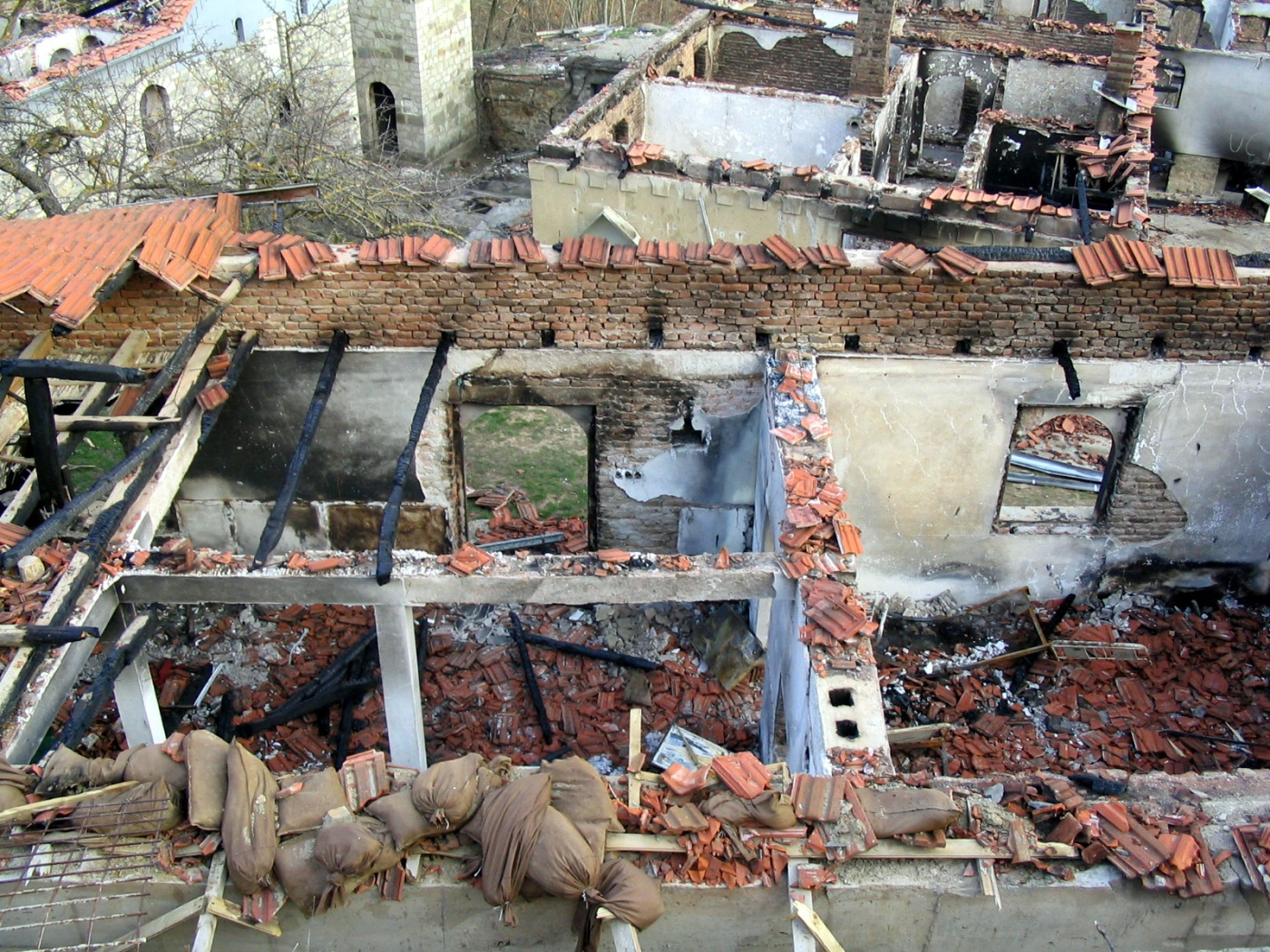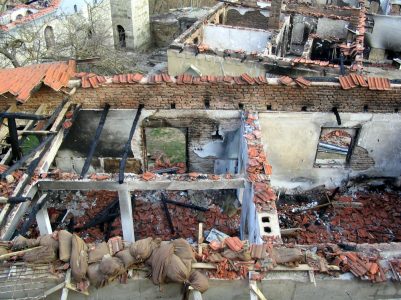By S.K. Moore, PhD.
– – –
The following is an account of a French Roman Catholic priest serving as a chaplain with NATO Forces under the auspices of the United Nations in Kosovo in 2004-2005. This two-part narrative illustrates the strategic effect of Religious Leader Engagement as an aspect of peacebuilding at the intersection of ethno-religious tensions and historical memory.
An Arduous Beginning: Conflict’s Residual Effects
Aumônier (Chaplain) Michel de Peyret had been to the Balkans before. In 2003, he served with NATO forces—a Franco-Spanish Tactical Group based out of Mostar, a region not untouched by the war. Like all of the Balkan states of the former multiethnic Yugoslavia, residual effects of the conflict were in evidence not only in the shell and bullet-pocked facade of the many partially-destroyed buildings, but in the discernible woundedness that stalked the people themselves. Not unlike other war-torn areas of the globe, the scars are often deep with those who have lost much.

De Peyret arrived in Kosovo in 2004 shortly after violence had broken out. In mid-March, over a 48-hour period, at least 33 riots erupted involving an estimated 51,000 protestors. All tolled, 19 people died—and 550 homes and 27 Orthodox churches and monasteries were burned, leaving approximately 4,100 internally displaced persons (IDPs) without home or shelter. A number of Serbian schools and a hospital were also damaged. According to Humans Rights Watch, incensed Albanian rioters predominantly targeted areas of Kosovo where the remaining vestiges of a Serb presence existed.[1]
Regrettably, French and German troops of the NATO Kosovo Forces (KFOR) were late in responding before bringing the mayhem under control. For the Serbian community, the carnage was real—as was their lingering resentment toward KFOR for failing to protect them during the rioting. Triggering the unrest was an inaccurate report of the drowning of three ethnic Albanian boys allegedly fleeing local Serbs. As it is known to do, violence rapidly spread throughout Kosovo with intensity, something referred to as exogenous shock.[2]
Of gravest concern to the Orthodox community was the damage inflicted on the monastery of Devič, deep in Albanian territory. It had been plundered and burned, leaving French troops no choice but to evacuate the nuns, due to continued Albanian violence and looting. This was the situation that Lieutenant-Colonel de Peyret inherited as a Roman Catholic chaplain with the French Army under the auspices of the United Nations Interim Administration Mission in Kosovo (UNMIK). Trust among the Serbian population in the KFOR Forces was at an all-time low.

As in many ethnically diverse societies, grievances can reach back centuries, becoming an inherited past for contemporary society. In this regard, the Balkans have a complex history inclusive of the Albanian and Serbian ethno-religious communities of Kosovo. Memories are long and the sentiments that historical events can evoke are lasting.
Restoring Trust: A Reconstruction Endeavor
With recent events having eroded faith in KFOR (and the French in particular) to provide security, it fell to de Peyret to rebuild the frayed trust between the Serbian religious community and KFOR. Etched in memory, his first visit to the monastery in Devič was a lesson in humility. He presented himself to the Serbian Orthodox Sisters as a Roman Catholic priest with the French KFOR Forces. As a man of God, he stood with them in their devastation, entreating what he might do to help. Initially wary of his overtures, they hesitantly agreed to a return visit—provided he would take them to investigate the nearby damaged cemetery.
After a few days, chaplain de Peyret returned to the monastery, bringing with him three additional French chaplains who immediately settled into the task of clearing away the debris and cleaning. At the end of the day’s work, he proposed that they return to continue cleaning the ruins of the monastery. The Brigade Commander agreed enthusiastically with the request to involve French soldiers in the repair of the monastery. The Sisters warmed to the idea of their aiding in the restoration. On designated days, as many as 60 troops would participate in the reconstruction.

Re-establishing the lost trust was critical to ongoing relations in the sector between KFOR and the Serbian community. Trust, once lost, is exceedingly difficult to regain. In this instance, the relational trust between the French and this religious order began to strengthen, becoming more resilient as it matured. Working trust is seen emerging as the Sisters focused less on the conflict and more on the benefits of continuing in relationship with the French. Once trust is engendered, strengthening it depends much on the integrity of the individual. Trust in the French increased due to the recognition of de Peyret’s reliability to follow through on his commitments, a benefit of his close affiliation with the French Command. This meant resisting the temptation to make promises that could not be kept and coming through on what realistically could be delivered.
As a sign of their restored trust, the Sisters of Devič disclosed to Chaplain de Peyret where they had hidden their treasured icons and paintings from the looters. News soon reached the local Orthodox Bishop, Monsignor (Mgr) Teodosije, of the reconstruction efforts by this French priest. The social capital that he earned with the Bishop during those initial meetings led to his becoming a pivotal figure during de Peyret’s second tour to Kosovo. What eventually emerged among the religious leaders of Kosovo no one could have foreseen.
– – –
S.K. (Steve) Moore, PhD has been a Padre in the Canadian Armed Forces for 22 years, with operational tours to Bosnia during the war (92-93), Haiti (97-98) and doctoral research in Kandahar, Afghanistan (2006). His post-doctoral work led to the chaplain operational capability, Religious Leader Engagement (RLE), now being integrated into military training. He has advanced RLE within NATO and the Commonwealth, increasingly assimilating a whole-of-government application—concepts now being adapted to the civilian sector. His publications include “Military Chaplains as Agents of Peace: Religious Leader Engagement in Conflict and Post-conflict Environments” (Rowman & Littlefield, 2013) and “Religious Leader Engagement as an Aspect of Irregular Warfare: the dénouement of a chaplain operational capability” (CANSOFCOM, 2020).
– – –
[1] Kosovo: Failure of NATO, U.N> to. Protect Minorities, https://www.hrw.org/news/2004/07/26/kosovo-failure-nato-un-protect-minorities, accessed 3 May 2021. The smaller minority group known as the Ashkali were attacked as well.
[2] See Ashutosh Varshney, Ethnic Conflict and Civil Life: Hindus and Muslims in India (New Haven CN: Yale University Press, 2002). Ethno-religious violence spreading from one centre to another where the populace had been free of conflict due to, according to his longitudinal study of six cities over a period of 50 years, a lack of civic integration across ethnic lines.


